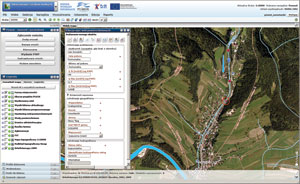ArcUser
Spring 2012 Edition
Making a Big SPLASH in Transboundary Water Resources Management
By Rafal Kokoszka, the Regional Water Management Board in Krakow, and Emil Zyszkowski, GISPartner
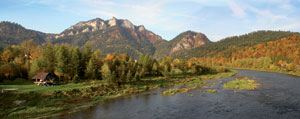
Three Crowns, the highest peak of Pieniny Mountains, a mountain range through which the Dunajec River flows. The Dunajec is a major river in the region covered by the PLUSK system. (Photo by Anna Bukowiec)
This article as a PDF.
As pressures on the natural environment from urbanization and economic development increase, we must take responsibility for earth's resources. Because globalization is pervasive and affects almost all aspects of our lives, the effects of our actions are not limited to one country. However, taking effective and coordinated action in transboundary areas that cover more than one country is even more complicated.
In recent years, water resources have become the subject of special concern by citizens and local governments. These concerns have been reflected in European Union (EU) directives. The natural level of geography for monitoring and protecting water resources is the river catchment. [A river catchment is all the land drained by a single river and its tributaries.] EU directives require water resources protection and management at this level.
To this end, Poland and Slovakia built a GIS named PLUSK (or SPLASH) that is designed to serve as a common platform for information exchange, analysis, and surface water and groundwater resources management. The project name comes from combining the international country name abbreviations for Poland (PL) and Slovakia (SK).
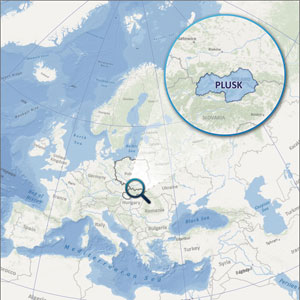
The PLUSK project is located along the border of Poland and Slovakia. Seventy percent of the project area is located in the Vistula River basin, and the remaining 30 percent is in the Danube River basin.
The system covers part of the Dunajec, Poprad, and Orawa river basins, an area of more than 6,700 square kilometers (km2), or about 2,600 square miles, located in a transboundary area between Poland and Slovakia.
The Regional Water Management Board (RZGW) in Krakow, Poland, along with Slovak Water Management Enterprise, State Enterprise (SVP), in Banska Stiavnica, Slovakia, have implemented a project titled Evaluation of Information System PLUSK for Common, Polish-Slovak Border Waters, for the Purpose of Water Framework Directive and Floods Directive Implementation. This project was cofinanced by EU under the Cross-border Cooperation Program, Poland-Slovak Republic 2007–2013.
Serving Poland and Slovakia
The PLUSK system serves users in both countries. Three groups of users are recognized and have varying levels of access to PLUSK data and tools:
- Government units responsible for conducting water policy (who are the most advanced-level users)
- Institutions, local government units, and major water users (who are intermediate-level users)
- Nongovernmental organizations, people in business with water issues, and of course the public (the basic-level users)
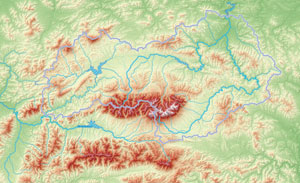
A hypsometric map of the PLUSK area showing the diverse topography that ranges from 300 meters to more than 2,650 meters above sea level
The goals for the system could not be accomplished unless a common database was created for the whole area. This required gathering specific information and harmonizing both the spatial and attribute aspects of the data.
One of the most important goals of PLUSK was implementing tools for elaborating quantitative and qualitative water management balance. These tools support implementing a River Basin Management Plan and help shape water use according to sustainable development rules. These rules will help mitigate the adverse use of ground and surface water.
PLUSK is designed to enhance the process of issuing water use permits by improving coordination and cooperation between Polish and Slovak agencies. A pilot program is planned for implementing the procedures required for coordinating the administrative actions related to issuing water use permits.
Each water use application is subjected to a two-phase analysis, conducted using system tools, that evaluates the impact of a new water use on water resources. Users access the system via a web map application. The portal publishes data as a map composition containing editing mechanisms for points of water removal or sewage discharge and tools for balancing water resources. The results of analysis are visualized on maps in a web app.
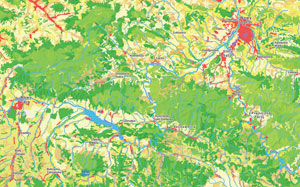
Land-use information is important in supporting analysis of water resources. Data from European Environment Agency (EEA)-CORINE Land Cover (CLC) was used.
PLUSK System
Building such a complex and specialized GIS involved specialists from different fields: water management and water resources balance experts, GIS specialists, database architects, analysts, and IT architects. The system was implemented by a consortium of GISPartner, Pectore-Eco, Innovation Technology Group, and Centrum Informatyki ZETO between November 2010 and September 2011. RZGW and SVP provided substantial support for this effort.
The result was a system built using the most modern solutions and software provided by Esri and GISPartner. It was composed of an Oracle/SDE database, ArcGIS for Desktop applications, and a web map portal created with ArcGIS for Server.
The PLUSK database, based on Oracle Standard Edition 11g, is the repository for reference data such as scanned topographic maps; orthophotos; administrative division layers; and key water management data such as hydrographic network, catchment division, quantitative and qualitative monitoring networks, localization of water removal and sewage discharge points, digital terrain models, and land use. All data required for conducting balance analysis is contained in this database. Spatial and attribute data from both countries has been harmonized into a coherent database that covers the whole area. Most operations related to populating the database, data update, verification, and harmonization were conducted in ArcGIS 10 for Desktop. Some data can also be updated using web app tools.
The PLUSK web map portal, a central component of the system, is based on a web mapping app called iMap 4.0 that was designed by GISPartner. The portal is displayed in two languages—Polish and Slovak—and provides access to data gathered in the system database.
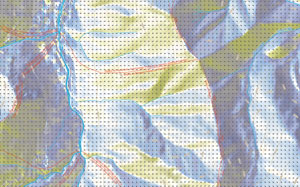
The catchment area is the perfect level of reference data. Here the surface aspect is marked with the flow directions for surface water.
The portal is divided into thematic modules. Each module is represented by a specific map that presents data for the chosen subject and a set of tools and actions for searching for and analyzing data along with creating reports. There are also editing tools specific to each module for editing attribute data for points of water removal and sewage discharge. The data and tools made available by the application are based on the user's authorization level. Water resources balance, surface waters, groundwaters, protected areas, catchment morphometry, and soils are the main PLUSK modules. The server portion of the portal, especially map and geoprocessing tools publishing, is based on ArcGIS 10 for Server Enterprise Advanced.
The key component of PLUSK is a set of functions for conducting the calculations and simulations needed for water resources balancing. These tools, in the form of geoprocessing services, are launched from iMap. Access to analytic functions is restricted based on membership in an authorized user group. For example, water resources analysts from RZGW have access to all functionality, while local government workers have access only to the resources necessary for preliminary verification of an application for issuing a water use permit.
Analysis results, presented as maps, graphs, and quantities, are accessed using dedicated web app tools. The results of a current balance calculation, based on water users who already have water use permits, are visible to everyone using the portal. The system can also be used to conduct variant analysis, which allows analysis of future water resources demand by changing the values of removals and discharges for existing water users or adding potential new users.
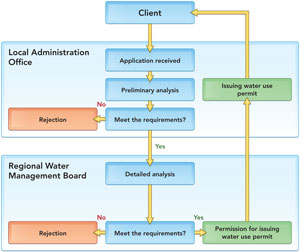
Diagram illustrating successive steps of the administrative procedure proposed for issuing water use permit
Tools for Balancing Water Resources
Balancing water resources makes use of a set of calculations and analytic procedures that cover the quantitative and qualitative comparison of groundwater and surface water resources with needs of current water users (or those applying for permission to use water). Balancing these needs takes into consideration the influence of water structures (i.e., retention reservoirs) and the requirements for protecting the natural environment. It is also the framework for expanding the concept of water resources management. Calculations are made for a specific area, usually a catchment or a portion of a catchment.
In PLUSK, tools for balancing water resources are crucial. This innovative approach is based on the full integration of the model with spatial information. Input data, such as localization of removal/discharge points, hydrographic network, catchment division, and water gauge localization, which are necessary for valid functioning of a model, along with streamflow measurement results, water structures, and localization of balance nodes used in the calculations, are taken and stored in database layers and tables.
Results are published as maps, graphs (i.e., profiles), and numeric values that can be accessed using the Identification tool. Previously, models developed in Poland using a spatial component had not been implemented as fully functioning, closed user applications. PLUSK is the first solution that integrates water resources balancing with a spatial component that has been implemented in the RZGW Krakow area. It is also the first system of this kind in Poland based on an Esri server solution.
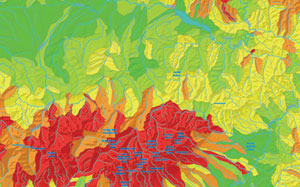
This map shows the average slope of fragmentary catchments. The wide range of data gathered in PLUSK allows users to prepare different types of analytic maps.
This new approach to balancing water resources gives users many options. Water use permit issuance can be linked with model balancing. The system dynamically takes new points of removal/discharge into consideration as soon as a water use permit is issued. The solution for balancing water resources is presented as an interactive map service, which enhances and speeds up the analysis of the impact of a new removal or discharge on water resources. Consequently, water use permits can be issued more rapidly but still be based on reliable data.
Verifying New Water Users
Reliable outcomes can be obtained only by using current data on existing water removals and sewage discharges. It was natural to integrate the process of receiving applications for water use permits with the tools for calculating water resources balance. PLUSK was implemented at several levels and involved different administration units.
Applications are registered in a local administration office and entered by a clerk into the system, including the location of the water removal or sewage discharge point, using a web app. A preliminary evaluation is made of the application using tools for calculating water resources balance. This evaluation identifies only cases in which inferred water removal or sewage discharge goes drastically beyond the available water resources.
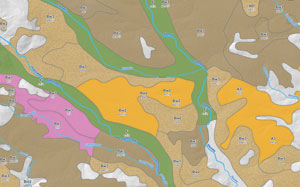
Because of substantial differences in soil marking methodology between Poland and Slovakia, harmonization of this data was one of the biggest challenges of the project.
The application is sent to specialists in RZGW Krakow for further analysis. The RZGW analyst, using the same tools, makes another analysis taking two aspects—quantitative and qualitative—into consideration. The quantitative analysis determines the quantity of water used by the applicant.
These results are illustrated on a map showing the returnable water withdrawal in relation to instream flow in a particular river section. Results are also graphed to show the guaranteed returnable water withdrawal with a specific probability of occurrence. This graph is a profile measured parallel to water course sections.
The results of a qualitative balance address loads, absorptivity, and the concentrations of biochemical oxygen demand, nitrogen, and phosphorus and are published as maps showing current concentrations in relation to threshold level and graphs of the hydrochemical profiles of rivers. After approval, the application goes back to the local government office, where a water use permit is issued. The entire process, including paperwork, is carried out in the PLUSK map portal.
Alternative Scenarios Analysis
Besides linking balance analysis to the issuing of water use permits, RZGW analysts conduct situational analysis (what-if scenarios) using the PLUSK system. The system models possible changes in water removal and sewage discharge values for existing users and can model additional hypothetical users so the effects of increased demand can be evaluated. Separate simulations can be conducted simultaneously by several analysts. These simulations have no impact on the current water resources balance.
Conclusion
The PLUSK project was designed to integrate water policy for international river basin districts and created an information exchange system for processing and publishing spatial information about the environment from a common database for the Polish–Slovak transboundary catchments. The system is based on Esri software and GISPartner solutions and is a very innovative approach to balancing demands on water resources. This unique approach was possible thanks to GIS.
The PLUSK implementation on the transboundary area will surely increase the effectiveness of the water resources evaluation process and will provide substantial organizational support for issuing water use permits. The system can be extended in its functionality and in the area administered without requiring modification to the web map application or water resources analysis tools. System expansion will require only adding spatial data to existing datasets.
If this pilot program for implementing cooperative procedures between the administration offices in two countries responsible for issuing water use permits and conducting water policy is successful, efforts may be made to extend it to other areas and possibly sanction it in law.
For more information, contact Rafal Kokoszka at the Regional Water Management Board or Emil Zyszkowski at GISPartner.
About the Authors
Rafal Kokoszka, PhD, has been an employee of RZGW in Krakow since 2001. He majored in environmental engineering and land surveying at the University of Agriculture in Krakow and received his doctorate in 2008. He uses GIS tools in his work every day.
Emil Zyszkowski is the manager of the GIS department at GISPartner. He obtained a master's degree in physical geography at Wroclaw University in 1995. Since 1994, he has been involved in GIS and has worked for GISPartner since its founding in 2003.
